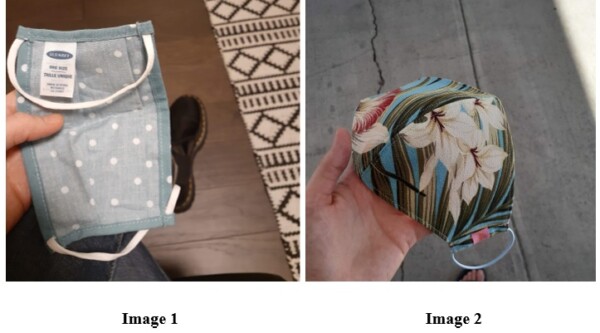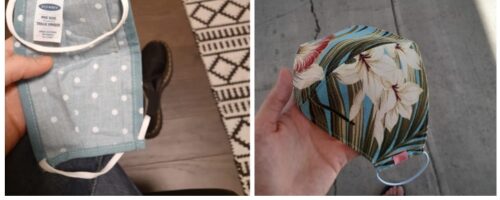
Emily Millichip, London Road, Edinburgh EH7 6AE, UK
How is it produced?
In 2020, when it became clear that under COVID-19 we would need to wear our own personal protective equipment (PPE) in British Columbia to help stop the spread of the virus, I purchased cloth face masks for myself and my family. Here, I focus on two different masks to showcase differences and similarities between them.
The first mask order I placed was for a child’s face mask and an adult’s face mask: produced by Old Navy, bought online, and shipped to Kamloops, BC (Image 1). Both the child size face masks and the adult size face masks came in packs of 5, all with different patterns. The children’s masks had a label which stated it was 100% cotton and “Made in China.” The adult’s masks had no labels at all. The second order I placed was for a single adult mask from Scottish designer Emily Millichip: manufactured in Edinburgh, Scotland, and sold online to be shipped to Kamloops, BC (Image 2). This mask has no label on it and does not indicate the specific material used. On the designer’s website, however, it states that the mask is “Zero Waste” and made from 100% cotton offcuts from the designer’s earlier collections (Millichip, 2021). The first came in a generic plastic bag, the second came with a handwritten note of thanks from Millichip herself. Here I examine the child’s mask and the adult mask from Millichip. With no information on the adult masks from Old Navy, I have not included them in my analysis.
- Old Navy Children’s Mask (Pack of 5): 15.00 CAN
- Old Navy Adult Mask (Pack of 5): 15.00 CAN
- Emily Millichip Mask: 25.00 GBP
Describe the supply chain to the store shelf in Canada:
In terms of distribution, both masks were purchased online, and shipped directly to my home in Kamloops, BC. The Old Navy masks were shipped through UPS shipments, and the Millichip mask came through Canada Post, via the Royal Mail. With the Old Navy mask, it is not clear how the mask moved form the factory in China to my home. Presumably, there is a distribution center in the United States (US), as the company websites indicates that online orders are only available for customers in the US and in Canada (Old Navy, 2021). While I received an email notification when the Old Navy mask had shipped, there was no capacity for me to track the package through UPS Shipments. Tracking the distribution of the Millichip mask, however, was simple. When this mask shipped, I received an email notification from Millichip providing me with a tracking number through the Royal Mail. I could track the package from the UK leg of its journey, all the way to my front door: it was first accepted at the Jewel Post Office [EH15 3AR] before travelling to a central Edinburgh sorting facility and eventually making its way to Royal Mail Langley Heathrow Worldwide Distribution Centre (HWDC), located at Heathrow Airport; from Heathrow it then travelled to British Columbia, arriving first at the Vancouver Pacific Processing Centre, in Richmond, BC, and then making its way to Kamloops via Canada Post.
What is the power balance between the producer and seller?
With respect to understanding power dynamics between producer and seller, there are important differences between these masks. Immediately, it is clear that there is a cost difference between the masks, with the mask from Millichip coming in at a more expensive price point. In the context of the production, the mask from Old Navy is associated with “fast fashion” production, a system known for worker exploitation by placing unrealistic production timelines on factories (Siegle, 2014). Worker rights have been further exploited under COVID-19 (Brydges and Hanlon, 2020). According to the Workers Rights Consortium (WRC), for example, Gap Inc. (the parent company of Old Navy), had been flagged for failing to compensate workers for orders that had been made under COVID-19. The company’s decision to pay workers in full for their labour changed only on the week of July 10, 2020 (WRC, 2021).
Meanwhile, the mask produced by Emily Millichip was stitched together by Millichip in her Edinburgh studio, sewn only once the order has been placed: “Each mask is made by hand. I will start on your mask as soon as possible and aim to have orders shipped within 4 weeks.” (Millichip, 2021). This timeline is significantly slower than that of Old Navy, who produces mass quantities of masks in advance of any orders taking place. Millichip also communicates with the customer that the timeline is flexible, which works to highlight the labour processes involved, and also manages customer expectations. While Millichip stitches the order herself, controlling the design and production processes “slow fashion” (Fletcher, 2008).
In terms of the materials used, reflecting on the producers working with material production, the information available on either mask is not clear. Although both masks are made from 100% cotton, cotton production is linked to forced labour in countries such as Uzbekistan and China (RSN, 2021). In a note which arrives alongside the mask, Millichip states that the mask is made from ‘quality materials sourced from Hawaii.” Without evidence to show any specifics, the use of conventional cotton challenges Millichip’s claims of a “zero waste” mask; waste is not exclusive to design and manufacturing processes.
Can you recommend changes to the system to improve the balance?
Differences between the two masks featured here appear glaring. While the Old Navy mask falls in line with expected and conventional practices of consumption under the logic of global capitalism—where workers are alienated from processes of production (Sullivan, 2016)—the Millichip mask stands apart, favouring slower, personal, and more transparent processes.
In terms of recommendations to improve the systems which made these masks possible, there are various pathways. Regarding labour rights, the Canadian government is working in a Modern Slavery Bill which would regulate companies selling their products within the Canadian market to confront the realities of “modern slavery” across their supply chains (Parliament of Canada (2020), much like the UK Modern Slavery Act (LeBaron and Rühmkorf, 2019). And yet, despite action on the legislative front, academic investigations into forms of modern slavery as a field of research are lacking (Caruana, R. et al.,2021).
Calls for increased transparency across global supply chains are on the rise, with companies under pressure from consumers to make public their list of suppliers (Fashion Revolution, 2015). This approach would impact supplier countries differently, depending on where the company sources their products. For example, amidst recent US and China discussions on trade, the company has claimed it will scale back production of goods from China (Friedman, 2020). Trade discussions between states play a key role on how a company operates. Of course, this is not only the case for large companies, but for small ones too: Millichip’s business, for example, would have been impacted by the recent exit of Britain from the European Union.
It is helpful to question the very idea that “fast” and “slow” fashion exists as such an extreme binary. As Pham (2017) points out, high-cost brands are also complicit in worker rights violations. Strategies for change should identify ways to amplify worker voices so that workers across global supply chains are not only heard but included in decision making processes. While the Millichip mask appears to have been produced under more favourable conditions than the Old Navy mask, nothing is certain. And I wonder about the stress and pressures faced by Millichip when she pivoted her business under CIVID-19, herself impacted by lockdowns, and the pressure to produce and keep her business afloat in the midst of a global pandemic. The financial forces driving decisions made by executives at Old Navy are a world away from those of a small business owner.
Unpacking the global production of PPE by comparing a “fast fashion” mask against a “slow fashion” mask has highlighted tensions related to so-called ethical consumption. As it turns out, a simple mask is not so simple after all. Purchased to protect myself and my family, I am left wondering how the health and safety of the designers, workers, and producers, were compromised along the way.
References/Resources:
Brydges, T., & Hanlon, M. (2020). Garment worker rights and the fashion industry’s response to COVID-19. Dialogues in Human Geography, 10(2), 195–198.
Caruana, R., Crane, A., Gold, S., & LeBaron, G. (2021). Modern Slavery in Business: The Sad and Sorry State of a Non-Field. Business & Society, 60(2), 251–287.
Fashion Revolution. (2020Transparency. Available: https://www.fashionrevolution.org/about/transparency/
Fletcher, Kate. (2008) Sustainable Fashion and Textiles: Design Journeys, London, UK: Earthscan.
Friedman, Arthur (2019). Gap Slashes China Sourcing, Eyes Old Navy Split as Way to “Win” at Retail. Sourcing Journal. Available: https://sourcingjournal.com/topics/sourcing/gap-china-sourcing-old-navy-154661/
Old Navy (2021). Shipping and Handling. Available: https://oldnavy.gapcanada.ca/customerService/info.do?cid=3315
LeBaron and Rühmkorf (2019). The domestic politics of corporate accountability legislation: Struggles over the 2015 UK Modern Slavery Act, Socio-Economic Review, 17(3), 709–743.
Millichip, Emily (2021). Zero Waste Face Mask – Blue Tropical. Available: https://www.emilymillichip.com/shop/zero-waste-face-mask-leopard-print-pink-ties-mdlxs
Parliament of Canada (2020). BILL S-211: Modern Slavery Act. Senate of Canada. Available: https://www.parl.ca/DocumentViewer/en/43-1/bill/S-211/first-reading
Pham, Minh-ha T. (2017) The High Cost of High Fashion. Available: https://www.jacobinmag.com/2017/06/fast-fashion-labor-prada-gucci-abuse-designer
Siegle, Lucy. (2014) We Are What We Wear: Unravelling Fast Fashion and the Collapse of Rana Plaza. Guardian Shorts.
Sourcing Network (2021). Cotton. Available: https://www.sourcingnetwork.org/cotton
Sullivan, A. (2016). Karl Marx: Fashion and Capitalism. In Rocamora, A., & Smelik, A. (Eds). (2016). Thinking through Fashion. A Guide to Key Theorists (28-45). London: I.B. Tauris.
Workers Rights Consortium. (2020). “Gap Inc. now paying in full.” Available: https://www.workersrights.org/updates-and-analysis/#Jul10Gap

